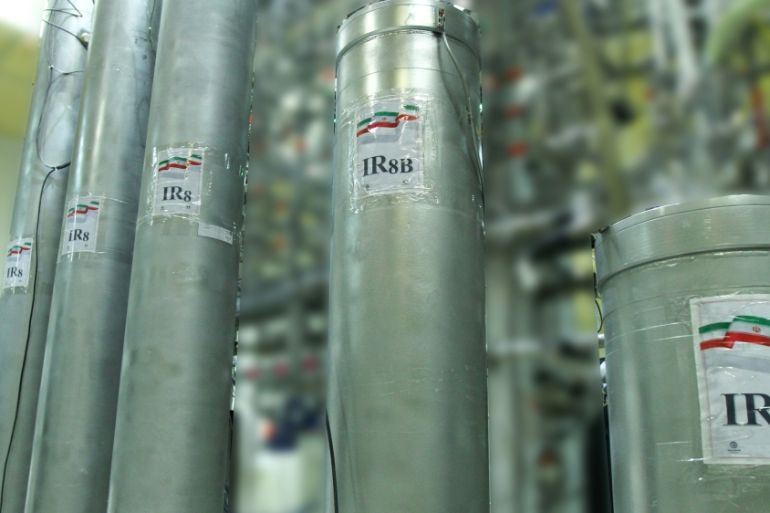Iran begins process of fuelling centrifuges at Fordow
Latest move means Fordow will move from its permitted status of research plant to become an active nuclear site.

Iran has started the process of injecting uranium gas into centrifuges at its underground Fordow facility, according to an official, the latest move away from its unravelling nuclear deal with world powers since the United States pulled out of the landmark agreement in 2018.
Behrouz Kamalvandi, spokesman for the Atomic Energy Organisation of Iran, told state television the agency has delivered 2000 kilograms of Uranium or UF6 to the Fordow plant, under the supervision of United Nations inspectors, on Wednesday.
Keep reading
list of 4 itemsBombs and viruses: The shadowy history of Israel’s attacks on Iranian soil
Russia says Ukraine attack hits Zaporizhzhia nuclear power plant
Nuclear energy cannot lead the global energy transition
“The restarting of the centrifuges will take a few hours and from midnight, the process of injecting uranium gas into them will begin,” he said.
A spokesman for International Atomic Energy Agency (IAEA) said its inspectors at the site “will report back on relevant activities”.
Ali Akbar Salehi, Iran’s nuclear chief, said on Tuesday Iran will enrich uranium to 5 percent at Fordow on Wednesday.
The accord, which was signed in 2015 by Iran, the US, Britain, France, Germany, China and Russia, bans nuclear activity at Fordow, a plant located near the city of Qom, and capped the level of purity to which Tehran can enrich uranium at 3.67 percent – suitable for civilian power generation and far below the 90 percent threshold of nuclear weapons grade.
Before the deal, Iran used Fordow to enrich uranium to 20 percent fissile purity. And Salehi said Tehran could also enrich uranium to 20 percent if needed, “but right now there is no need for that”.
With the injection of uranium gas into its centrifuges, Fordow will move from its permitted status of research plant to become an active nuclear site.
|
|
Iranian President Hassan Rouhani on Tuesday gave his European partners another two-month deadline to protect Iran’s economy – especially its banking and oil sectors – from the crippling US sanctions.
The nuclear deal can only be rescued if the remaining signatories helped Iran circumvent Washington’s measures, he said.
“We can’t unilaterally accept that we completely fulfil our commitments and they don’t follow up on their commitments,” he said, adding all of the steps Iran has taken so far are reversible and Tehran will uphold all of its obligations under the deal when the remaining signatories do the same.
France and Britain, however, condemned the move on Tuesday, while Russia said it was concerned.
“Iran’s latest actions clearly contravene the deal and pose a risk to our national security,” said Dominic Raab, Britain’s foreign minister. “We want to find a way forward through constructive international dialogue but Iran needs to stand by the commitments it made and urgently return to full compliance.”
Dmitry Peskov, spokesman for Russian President Vladimir Putin, said Moscow was “monitoring the development with concern and would like the deal to remain in place.
A spokeswoman for the European Commission expressed similar concern, adding “it is increasingly difficult to preserve” the deal.
|
|
Al Jazeera’s Dorsa Jabbari, reporting from Tehran, said the move to fuel the 1,044 centrifuges at Fordow was a “contentious” move.
“This is the only facility that can produce 20 percent uranium … And that has always been a point of contention with the international community – because going from 20 percent to the weapons-grade level of 90 percent is not a long stretch,” she said.
The measure on Wednesday is the fourth step announced by Iran since it began responding to Washington’s abandonment of the nuclear deal.
On Monday, a spokesman for Iran’s atomic agency announced it had doubled the number of advanced IR-6 centrifuges now in operation.
Such centrifuges can produce enriched uranium 10 times faster than the first generation IR-1s allowed under the accord.
Meanwhile, UN nuclear inspectors reported in July that Iran had cranked up uranium enrichment to 4.5 percent purity, beyond the 3.67 percent set in the accord, and started amassing more low-enriched uranium than the 300kg stockpile limit set in the deal.